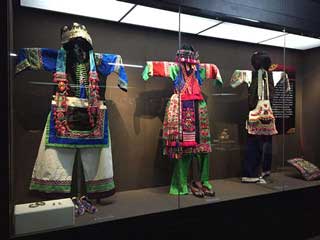- +86-13267351235
- info@globalstourtravels.com
Since the day that Chinese clothing became part of Chinese life, it has been endowed with different content, such as social status, customs, aesthetics and all kinds of cultural concepts. The dress has been the most direct and realistic reflection of the social and historical situation. In this sense, the history of Chinese clothing is, at the same time, a living history of the development of civilization.



Reforming Military Clothing - King Willing of Zhao
Casual Clothes of Song Dynasty
Chinese clothing can be traced back to the primitive society of the late Paleolithic Period. Archaeologists have found that 20,000 years ago primitive people who lived near modern-day Zhoukoudian, Beijing, wore ornaments. The white small stone beads, yellowish green cobbles, animal teeth, blood clams and fish bones with furrows unearthed at Zhoukoudian are exquisitely pierced, and traces of hematite powder remain on hole walls. According to the places where they have been found, experts think that these items were necklaces. These people wore ornaments not just for decoration but also to ward off evil spirits and as part of prayer rituals. Long round openings still remain on unearthed bone needles, which demonstrate that ancient people of this period could sew animal hide with needles.
In Qinghai Province, in the west of China, painted pottery basins made more than 5,000 years ago have been unearthed. The patterns on these pottery basins look like dancers doing a hunting dance. The dancers wear plaited ornaments on their heads, tail ornaments hang around their waists, and some wear round skirts. A painted pottery bottle unearthed in Gansu also attracts the attention -it is painted to resemble a girl, with short hair on the forehead above the eyebrows, shoulder-length hair at the back of the head, clearly discernable facial features, and continuous patterns below the neck consisting of three layers of oblique lines, arcs, and triangles. It is thought that these patterns depict clothing.
Chinese clothing and head gear was formalized during the Western Zhou Dynasty (1046-771 BC). The Zhou Dynasty established official positions such as the "clothes minister," "inner clothes minister" and "jade official", responsible for the clothes and jade ornaments of the emperor and empress. There were different clothing rules for the emperor and for ordinary people. From the Han Dynasty (206 BC-220 AD) onwards these rules were recorded in official history books such as Records of Carriages and Clothing.
During the Tang Dynasty (618-907) China was powerful, society was more open, and clothes were beautiful. Fashions changed more frequently and women wearing low-neck short gowns or men wearing narrow-sleeved dresses became a symbol of the greater social tolerance of the period. The Tang Dynasty was the most splendid era of Chinese clothing. Read more
Coexistence of Chinese and Western style Clothes
Workers' Clothes and Farmers' Clothes
Popular Fashion at the end of 20th century
Preserving the Han Style of Clothing
After 1840, China became a modern society as  the number of trading ports increased and more cosmopolitan cities, such as Shanghai, saw the integration of Chinese and Western cultures. Driven by European and American fashion trends, traditional Chinese clothes began to change. In the first half of the 20th century, Chinese clothes underwent a period of integration with Western clothing and this fusion can be seen in cheongsams, long gowns, tunic suits, school uniforms, Western-style clothes, hats, silk stockings, and high-heeled shoes. After the founding of the People's Republic of China in 1949, clothes that elevated the status of laborers, such as workers' clothes and farmers' clothes emerged. In the 1980s, after China began to reform and open up to the rest of the world, jackets, bell-bottomed pants, jeans, miniskirts, bikinis, professional suits, punk clothes, T-shirts, etc. were embraced by the Chinese people. Clothes, like people, have been witness to changing times. Read more
the number of trading ports increased and more cosmopolitan cities, such as Shanghai, saw the integration of Chinese and Western cultures. Driven by European and American fashion trends, traditional Chinese clothes began to change. In the first half of the 20th century, Chinese clothes underwent a period of integration with Western clothing and this fusion can be seen in cheongsams, long gowns, tunic suits, school uniforms, Western-style clothes, hats, silk stockings, and high-heeled shoes. After the founding of the People's Republic of China in 1949, clothes that elevated the status of laborers, such as workers' clothes and farmers' clothes emerged. In the 1980s, after China began to reform and open up to the rest of the world, jackets, bell-bottomed pants, jeans, miniskirts, bikinis, professional suits, punk clothes, T-shirts, etc. were embraced by the Chinese people. Clothes, like people, have been witness to changing times. Read more
Stories about Chinese Ethnic Clothes
Ethnic Clothes in the Age of the Internet
China is a multinational country (with 56 different ethnic groups) and clothing styles and customs are constantly changing - like flowers in a garden, always providing color, interest and beauty. Read more